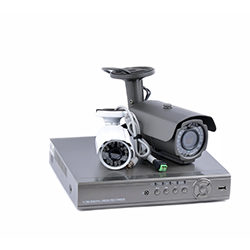
The ability to customise IP video surveillance cameras with third-party apps has been a game-changer in system design and implementation. Traditional analytics require streaming all video to a server or external processor for deep interpretation to detect a license plate, face, or other criteria in each video frame. Apps perform image processing within the camera for direct output, turning this model upside down.
By allowing end users to customise specific cameras with the specific functionality they need based on location, application and more, camera apps provide flexibility that is unheard-of with traditional server-based processing and analytics solutions. On a system-wide scale, the potential savings can be tremendous.Embedded software functionality within cameras using an app delivers the freedom to deploy the combination of functionality and performance users need to meet their specific requirements, a level of flexibility and customisation that is unheard of with server-based solutions.
The ability to embed software functionality into individual cameras using an app eliminates the need for centralised software and servers to greatly reduce overall costs. With apps installed directly on the camera, customers can continue to use their existing camera hardware, which not only saves on up-front purchase prices for new hardware but also increases that camera’s ROI. The ability to run multiple apps concurrently translates into even greater camera functionality and further maximises ROI. Additionally, many app developers are agile enough to be able – and willing – to customise features and functions rapidly and cost-effectively.
By integrating directly with the camera, third-party apps take advantage of the best image performance without affecting camera operations. With full edge processing, the app can communicate directly to the digital signal processing DSP or raw video data prior to encoding. A 100 percent embedded app enables more effective and accurate analytics, with performance levels that are not dictated by server load or specifications.
In a hybrid model, analytic functions and operations are distributed between the app installed on the camera and the server. This provides end users with higher performance from distributed analytics while reducing the cost of installing several servers to handle image processing, as well as the cost of server performance. For example, without an app to shoulder some of the processing load, a server might be capable of handling 20 cameras. With an edge app, that same server could handle up to 200.
Because image processing and analytics are applied at the edge, apps offer the ability to better manage and conserve bandwidth by eliminating the requirement for large amounts of dedicated bandwidth. Apps remove the bandwidth-intensive need to stream the entire full-resolution video to a server for processing, as well as the need to send duplicate data streams to both the analytics server and the VMS. These solutions also provide additional bandwidth savings resulting from the ability to view low-resolution live video, while analytics are applied to the high-resolution profile simultaneously. As camera counts increase, bandwidth savings scale up as well.
In order to take advantages of these benefits, there are a number of considerations for integrators and end users when evaluating and choosing third-party camera-based apps, many of which are available for demo to ensure performance and many of the key factors listed below.
1. Compatibility: The first consideration is to verify an app’s compatibility with an end user’s desired, or existing cameras. Some apps are designed for specific camera models or form factors. It’s also important to ensure that the right camera is being used for the application (form factor, lens, resolution, IR, etc.)
2. Cybersecurity: Network breaches are all too common today, as hackers continually ramp up their efforts to access sensitive data via any networked device possible. Therefore, it is critical to use only approved apps from trusted partners to ensure that malicious code will not be installed on security cameras. Just as important is to carefully consider the permissions an app will need and where and to what the data it generates will flow. In addition, camera apps can eliminate continuous video streams from being sent to an analytics server, thereby reducing an attack vector or source of disclosed data.
3. Additional requirements: A good camera app should be flexible and be capable of growing along with an end user’s needs, making this an important factor in the evaluation and selection process. Some apps may still require a back-end server or cloud connection to function properly or grow beyond a standalone camera, so the potential costs associated with these must be factored into the decision-making process
Another tangible benefit that camera apps offer is in their ability to deliver valuable data to previously unrelated systems to help end users fulfil their primary security and surveillance needs and much more. For example, a school may want to capture the license plates of cars entering the pickup/drop-off lane so that in case of an incident, a hotlist plate can be entered for notification. A license plate recognition solution would allow the school to easily search video based on plate number rather than manually sifting through hours of video. However, because this application requires only a single camera, an on-board license plate recognition app makes more financial and operational sense, as a server-based solution would be more expensive and less efficient.
Without question, camera-based apps represent a convenient, cost-effective way for end users to make sure their surveillance system meets the needs of their specific applications. Compared to traditional server-based processing models, the combination of flexibility and efficiency allows users to deploy apps to increase functionality when and where it is most needed while delivering potentially tremendous cost savings and increased ROI across the entire enterprise.











